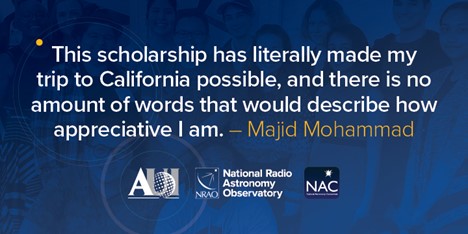AUI will present at the 247th meeting of the American Astronomical Society in Phoenix from January 4-8.
Recent News
ALMA Helps Unmask Monster Black Hole Behind Record-Breaking Cosmic Burst
Astronomers have used the Atacama Large Millimeter/submillimeter Array (ALMA) together with a suite of space- and ground-based telescopes, to study AT 2024wpp, the most luminous fast blue optical transient (LFBOT) ever observed.
Astronomers Make First Radio Detection of Rare Supernova Type, Revealing Secrets of Stellar Death
Astronomers using the U.S. National Science Foundation Very Large Array have captured the first-ever radio signals from a rare class of stellar explosion known as a Type Ibn supernova.
New Scholarship Established by the AUI Board of Trustees

AUI and the National Radio Astronomy Observatory (NRAO) today announced the establishment of the AUI Board of Trustees NAC Bridge Scholarship Award. This new scholarship is designed to assist and recognize National Astronomy Consortium (NAC)* alums who have completed their undergraduate programs and are beginning the next phase of their academic careers in Fall 2021.
NAC is a competitive program offering summer astronomy research internships to undergraduates and professional development programming and research opportunities throughout NAC alumni’s academic careers. NAC’s goal is to increase the number of students, often underserved by the traditional academic pipeline, in STEM and STEM careers, by creating a diverse network of support for their academic and professional careers from an early stage.
Amidst the excitement of beginning graduate school, there can also be financial burdens related to moving to a new location and establishing a new residence. The AUI Board of Trustees established the new NAC scholarship award with the hope that it will help NAC alums transition to graduate school.
This year, nine NAC alums have accepted offers from outstanding graduate programs around the country. Each will receive a $5,000 AUI Board of Trustees NAC Bridge Scholarship Award, with AUI and NRAO’s congratulations and best wishes for a smooth start to an exciting new chapter of their lives.
A key component of the NAC program has been the long-term sustained engagement of alums and, perhaps most importantly, the peer and near-peer support that NAC alums offer to each other. NRAO and AUI appreciate the commitment that NAC alums have to each other and to their own professional journeys, and are proud of their individual and collective accomplishments.
2021 Recipients of the NAC Bridge Scholarship Award
- Adria Peterkin, Massachusetts Institute of Technology, Nuclear Science and Engineering
- Theodore Octavio Pena, University of Wisconsin—Madison, Astronomy
- Allison Erena, University of Wisconsin—Madison, Astronomy
- Samantha Garza, University of Washington—Seattle, Astronomy
- Fatima Zaidouni, Massachusetts Institute of Technology, Physics
- Leonardo Clarke, University of California—Los Angeles, Astronomy & Astrophysics
- Majid Mohammad, University of California—Santa Barbara, Physics
- Alia Wofford, George Mason University, Climate Dynamics
- Mihika Rao, University of Virginia, Astronomy
About NAC
The National Astronomy Consortium (NAC) is a program of the National Radio Astronomy Observatory, a facility of the National Science Foundation, operated under cooperative agreement by Associated Universities, Inc. The NAC is a summer research experience program for undergraduate students in the United States who have been underserved by the traditional academic pipeline. The program aims to increase the number of students in STEM fields by providing research opportunities and facilitating the development of networks of support for success early in their academic careers and beyond.
Recent News
AUI to Attend AAS 247 Conference
AUI will present at the 247th meeting of the American Astronomical Society in Phoenix from January 4-8.
ALMA Helps Unmask Monster Black Hole Behind Record-Breaking Cosmic Burst
Astronomers have used the Atacama Large Millimeter/submillimeter Array (ALMA) together with a suite of space- and ground-based telescopes, to study AT 2024wpp, the most luminous fast blue optical transient (LFBOT) ever observed.
Astronomers Make First Radio Detection of Rare Supernova Type, Revealing Secrets of Stellar Death
Astronomers using the U.S. National Science Foundation Very Large Array have captured the first-ever radio signals from a rare class of stellar explosion known as a Type Ibn supernova.
